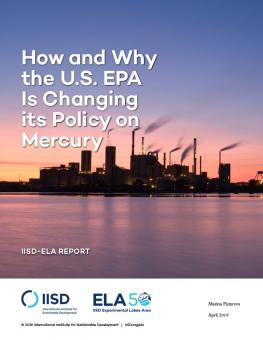
How and Why the U.S. EPA Is Changing its Policy on Mercury
President Trump wants to loosen the US EPA's regulations on mercury. We explore what the proposed changes are, why they would be a mistake and how they could affect the lives of Americans and even Canadians.
President Trump wants to loosen the U.S. EPA's regulations on mercury. We explore what the proposed changes are, why they would be a mistake and how they could affect the lives of Americans and even Canadians.
Key Messages
- President Donald Trump is trying to change the criteria by which the U.S. EPA judges the impact of mercury on human health, and duly reduce the restrictions on how much mercury can end up in the atmosphere.
- The existing mercury regulations have been highly effective at improving human health and saving lives.
- The proposed loosening of regulations would ignore the value of "co-benefits"—a mistake that does not paint a complete picture of the regulations' effectiveness and would set a dangerous precedent for the U.S. EPA.
11,000 premature deaths prevented, 4,700 fewer heart attacks and 130,000 fewer asthma attacks.
These are just some of the benefits of the current U.S. EPA regulations on mercury emissions. These are the very regulations that President Trump is trying to change this year.
In short, the EPA is reconsidering the importance of co-benefits in its calculations to determine the impact of its mercury regulations on industry and public health. Co-benefits—side benefits that are in addition to the direct benefits resulting from a policy—are traditionally assigned a monetary value and included in EPA policy calculations to justify pollution regulations.
In this short policy brief, we explain what the intended changes are, why discounting the value of co-benefits is a mistake and sets a dangerous precedent for the U.S. EPA's regulations procedure going forward, and what this could mean for the lives of millions of American and Canadians.
Participating experts
You might also be interested in
Microplastics now pervasive in Great Lakes, with 90% of water samples surpassing safe levels for aquatic wildlife: new studies
Data spanning the last ten years reveal that the Great Lakes basin is widely contaminated with microplastics, with potentially dangerous consequences for the wildlife that live within.
These nearly invisible organisms help clean Lake Tahoe's water. Here's how they do it
Plankton are not just a diabolical mastermind on a Nickelodeon show about a sponge who lives under the sea. Lake Tahoe is filled with them—the good kind. Tahoe native zooplankton are making a comeback in the more than 21-mile long lake, helping it look the clearest it has in 40 years. A comeback because until now, the microorganism's population significantly decreased after it's primary predator, the Mysis shrimp, was on the rise, according to previous Sacramento Bee reporting.
On World Wetlands Day, the world’s 'Great Lakes' are Exhibit A for why wetlands matter: Ted Lawrence
It might not be grabbing headlines around the globe, but tomorrow's U.N. World Wetlands Day matters. Wetlands across the globe provide many services, from improving water quality and protecting from floods and droughts, to providing habitats for countless flora and fauna, much of which we depend on. More broadly, World Wetlands Day accords us a rare and precious opportunity to celebrate North America’s abundant — but certainly not infinite — freshwater supplies.
Wyden investigation of fish contamination is an important step
I am pretty accustomed to reading headlines detailing the latest health issues plaguing our freshwater fish. It comes with the territory as an ecotoxicologist working on the health of North America's relatively abundant, but certainly not infinite, freshwater supplies.